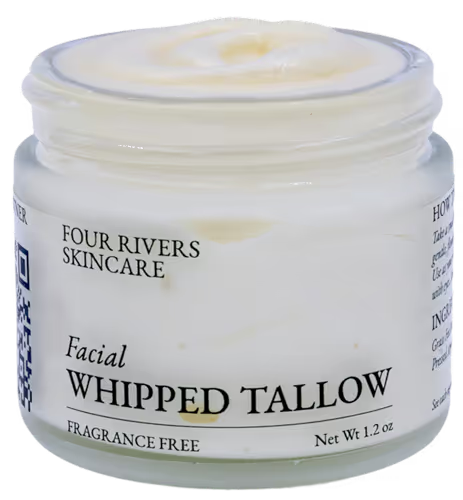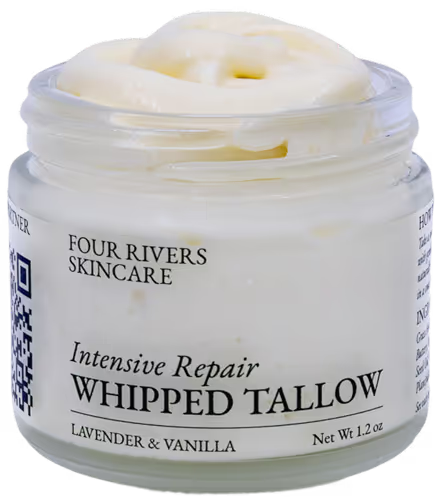.jpg)
.jpg)
.jpg)
Why Your Tallow Source Matters More Than You Think
Walk into any grocery store and you'll see the price difference between grass-fed and grain-fed beef. Most people assume this is just marketing hype or a premium for "natural" farming methods.
But when it comes to skincare, the difference between grass-fed and grain-fed tallow isn't just about farming philosophy. It's about measurable nutritional superiority that translates directly to better results for your skin.
What Cattle Eat Changes Everything
The difference starts with diet. Grass-fed cattle spend their lives grazing on pasture, eating what their digestive systems evolved to process. Grain-fed cattle are typically confined and fed corn, soy, and other grains to fatten them quickly for market.
This isn't just about animal welfare. What cattle eat fundamentally changes the composition of their fat, including the tallow that ends up in your skincare.
Think of it like this: if you ate nothing but processed food for months, your body composition would be different than if you ate a varied, natural diet. The same principle applies to cattle.
The Nutritional Difference is Real
Laboratory testing shows consistent differences between grass-fed and grain-fed tallow:
Vitamin K2 levels are typically three to five times higher in grass-fed sources. This vitamin supports skin elasticity and helps maintain smooth, healthy-looking skin.
Conjugated linoleic acid (CLA) concentrations can be dramatically higher in grass-fed tallow. CLA has anti-inflammatory properties that help calm irritated skin and support barrier function.
Beta-carotene gives grass-fed tallow its slightly golden color and provides antioxidant protection against environmental damage.
Omega-3 fatty acids are present in better ratios, helping balance inflammation and support overall skin health.
These aren't small differences. We're talking about measurable nutritional advantages that you can actually test in a lab.
How This Affects Your Skin
The superior fatty acid profile of grass-fed tallow means it works better with your skin's natural processes:
Better absorption: The optimized composition penetrates more effectively, delivering nutrients where they're needed rather than sitting on the surface.
Reduced inflammation: Higher levels of anti-inflammatory compounds help calm sensitive or reactive skin types.
Enhanced stability: Grass-fed tallow's natural antioxidant content helps prevent rancidity, keeping your products fresh and effective longer.
Improved compatibility: The balanced fatty acid profile more closely matches human sebum, making it feel more natural and comfortable on skin.
The Processing Advantage
Grass-fed operations tend to be smaller and more focused on quality than industrial grain-fed facilities. This often translates to:
Better traceability: We can verify exactly where our cattle lived, what they ate, and how they were processed.
Cleaner processing: Smaller operations typically have less need for antibiotics and other interventions that could affect final product quality.
More careful handling: Lower-volume processing allows for more attention to each batch, ensuring consistent quality.
Why the Premium is Worth It
Grass-fed tallow costs significantly more to source. The cattle require more time, land, and management. Processing volumes are smaller, increasing per-unit costs.
But this isn't about paying more for the same thing. The nutritional superiority and enhanced performance justify the premium. You're getting a fundamentally better ingredient.
It's the difference between regular gasoline and premium fuel. They'll both make your car run, but one performs demonstrably better.
How to Spot Quality Claims
Not all "grass-fed" claims are equal. Some operations use grass-fed cattle but finish them on grain, which can compromise the final nutritional profile.
Look for brands that provide specific information about their sourcing. Quality companies will tell you where their tallow comes from and how the cattle were raised throughout their entire lives.
At Four Rivers Skincare, we work exclusively with suppliers who can document grass-fed practices from birth to processing. We verify quality through testing and direct relationships with our sources.
The Environmental Connection
Grass-fed cattle support regenerative agriculture practices that improve soil health and sequester carbon. While this doesn't directly affect your skin, it reflects a commitment to sustainable practices throughout the supply chain.
When you choose grass-fed tallow skincare, you're supporting farming methods that work with natural systems rather than against them.
Real Results You Can Feel
These differences aren't just measurable in laboratories. Customers consistently notice:
Richer texture that feels more luxurious during applicationBetter absorption with less greasy residueLonger-lasting benefits between applicationsImproved skin response over time with regular use
The Four Rivers Standard
We chose grass-fed tallow not because it sounds better in marketing, but because it performs better on skin. Every batch we receive is tested for purity and nutritional content to ensure it meets our exacting standards.
This commitment to quality sourcing extends to every ingredient we use. We believe your skin deserves the best available inputs, regardless of cost.
The difference starts in the pasture, but it ends with better results for your skin.
Experience ingredients chosen for performance, not just philosophy. Discover why Four Rivers sources only the highest quality grass-fed tallow.


